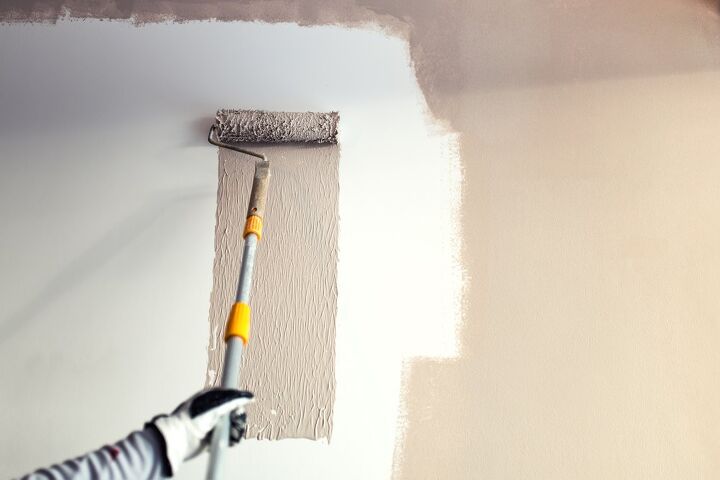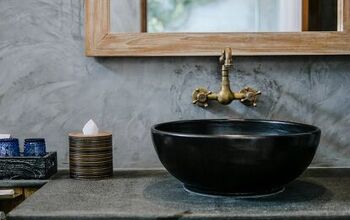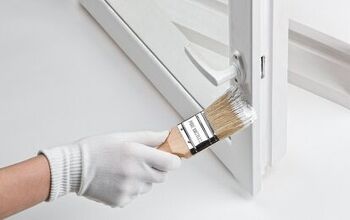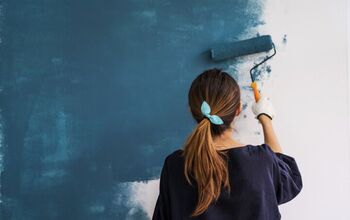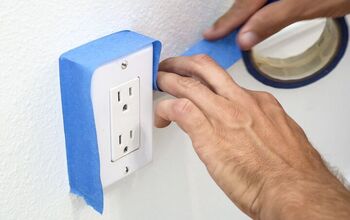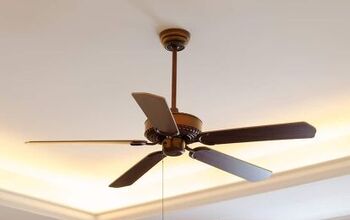Can You Paint Inside When It Rains? (Find Out Now!)

Getting ready for an indoor painting project is exciting. The anticipation of freshly painted walls and a new look for your interior creates eager anticipation. But what if you are ready to begin your painting project and the weather forecast calls for days of rain?
You can paint inside when it rains as long as you plan accordingly. It takes longer for paint to dry in wet conditions so be sure to allow extra time for the project. Use a dehumidifier or air conditioner in the room a day prior and throughout the project for best results. Use fans for increased air circulation and to help facilitate the drying process.
Rain does not have to put a damper on your indoor painting project. It will require additional equipment and time for optimal results, but you likely have the additional equipment in your home already. Before you begin to paint indoors on a rainy day you should first plan out the schedule for the project.
Do You Need to Hire a Paint Contractor?
Get free, zero-commitment quotes from pro contractors near you.

Map Out Your Project
Before you pick up a brush to paint inside when it rains you should map out a timeline. Painting inside when it rains will take significantly more time than painting in ideal conditions so you should plan accordingly.
Check The Forecast. Look at the detailed forecast for the time you plan to paint. Look for any gaps in rain and humidity. Try to plan painting and drying during the less humid times of day.
Create A Timetable. Painting inside when it rains will take longer. Be sure to allow ample drying time and more time for setup and breakdown. Also, make sure you budget enough time for each project element so the overall project does not go unfinished.
Gather Necessary Tools. There are extra tools required when you paint inside when it is raining outside. Be sure to gather extra fans and a device that will help remove moisture from the air.
Use a Dehumidifier
A dehumidifier is a highly effective accessory when you paint inside while it rains. A dehumidifier’s job is to remove excess moisture from the air. You can paint with confidence if you have an effective dehumidifier and you properly seal the windows to the space you are painting.
When you paint during long periods of rain and humidity it is helpful to turn on the dehumidifier a day before you plan to start painting. This will ensure the air and the surfaces of the room have a low moisture level.
Turn on Air Conditioner
If you are painting on a rainy day in the summer or in a warm climate then an air conditioner can be very helpful. Air conditioners are most often turned on to lower temperatures in hot rooms. They are also highly effective in removing moisture from the air, similar to a dehumidifier.
If you do not have a dehumidifier you can use your air conditioner instead, even on a cooler day. Turn the air conditioner on in the room you plan to paint one day prior just like you would with a dehumidifier. Keep the unit running throughout the painting process to help with circulation.
Make Sure Surfaces are Dry
If you paint inside when it rains it is imperative the surfaces you plan to paint are clean and dry before you start. This is especially important when it is humid and raining.
- Turn On Your Dehumidifier. You should turn your dehumidifier on for several hours or a full day before you begin the painting process. Be sure the windows are shut to ensure the humidity in the room decreases significantly.
- Inspect The Surfaces. Before you wash the surfaces you should inspect them to see if any specific cleaning tools are needed. Look for any mold. Mold is a sign that the area is naturally damp. Damp surfaces can deeply hurt the quality of a paint job.
Tip: Don’t paint on an area that will be dropped on by rain or condensation. Moisture can prevent paint from adhering. When air and water seep into the wet paint it can crack and peel.
- Wash Walls Thoroughly. Be sure to scrub and wipe away all dirt, oil, or other surface stains.
- Allow Ample Time to Dry. Even with your dehumidifier on, be sure you allow ample time for the wiped surfaces to dry. It is very important the surfaces are as dry as possible before you start painting.
- Check Temperature. Make sure the room is not too hot or cold to paint. Ideal temperatures for painting are between 50 and 70 degrees.
Allow Extra Drying Time
Normal interior paint usually dries within two hours or less. When it is raining outside and the humidity is higher it can take much longer.
As a rule you should consult the label on your paint can for average drying time. You can check the progress of the paint after normal drying time. To be safe it is good to paint at least one extra hour or simply double the standard drying time.
Use Fans To Increase Air Circulation
Fans are a very helpful tool when you paint on a rainy day. Using fans is a great way to circulate air in a room. This constant airflow promotes paint drying.
When you use fans you do not need to blast them on high directly at the freshly painted surface. The goal is to promote airflow. Ceiling fans or box fans directed at an angle or in a doorway will work great to help dry the paint. Fans can also help defuse any potentially dangerous fumes from the paint.
Be Cautious of Fumes
Any time you paint you should be cautious of fumes. Although most interior paints are not toxic, some are. Some paints contain Volatile Organic Compounds (also known as VOCs) that can cause short-term and long-term health effects. As always, be sure to look carefully at your paint container to see if there are hazardous fumes involved with your paint.
Even if your paint is not toxic, you should still be aware of fumes when you paint in the rain. Often when you paint in the rain you paint with all windows shut and sealed. Fans can help promote airflow but be sure to take breaks when needed to get fresh air outside the room.
Keep An Eye On Forecast
Weather can often change rapidly throughout the day. Be sure to keep an eye on the daily and three-day forecast for any shifts in weather.
Look for pockets in the day when it is not raining or when the humidity drops. Do your best to open the windows and allow airflow when the humidity drops or the rain stops. This can assist in the drying process and will help disperse paint fumes.
Related Questions
What Is The Best Humidity Level For Painting?
The ideal humidity level for painting is between 40% and 50%. When the humidity is too high it can negatively affect the way the paint dries. You should avoid painting when the humidity is very high (above 85%). Lower humidity is better for painting, but you do not want to be very dry either. It is important to have balanced humidity in order to let the paint dry at its intended pace.
Can I Paint Outside If It Is Raining?
If you plan to paint outside when it is raining you need to make sure the surface you paint does not get wet. If paint gets wet while you paint or as it dries it will not dry properly and can ruin the paint job.If you need to paint outside when it is raining be sure you have a protective cover above. Use a tent or tarp as a shield from any potential moisture and allow ample time for the paint to dry between coats.
When Is It Too Cold To Paint?
When you prepare to paint the temperature can be as important as the humidity. As a general rule, you should not paint when the temperature stays below 50 degrees Fahrenheit. Additionally, it is important to look at the temperature for the next several days after you paint. The temperature should not dip below 32 degrees for the next few days. Temperatures below freezing on fresh paint can cause cracking in the paint.
Do You Need to Hire a Paint Contractor?
Get free, zero-commitment quotes from pro contractors near you.

Final Thoughts
You do not have to let the rain wash away your indoor painting plans. Although mild sunny days are ideal for painting you can still have great results on a rainy day as long as you take the right steps to plan the project accordingly.
Using a dehumidifier or air conditioner will make painting indoors much easier. If you are able to lower and control the humidity in the room you paint then the results should be similar to those if you painted on a perfect day. Be sure the walls are very dry before you paint.
Once you finish each coat, allow a lot of extra time, and be sure you have fans in the room to let the air circulate and promote faster drying times.

Tom Gaffey is an expert writer who currently resides in Washington D.C. Tom has a passion for real estate and home improvement writing, as well as travel and lifestyle writing. He lived the last twelve years in Hawaii where he worked closely with luxury resorts and event planners, mastering his knowledge of aesthetics and luxury products. This is where he found his passion for home improvement and a keen interest in DIY projects. Currently, Tom resides in Washington D.C, and also working on his debut fiction novel.
More by Tom Gaffey



